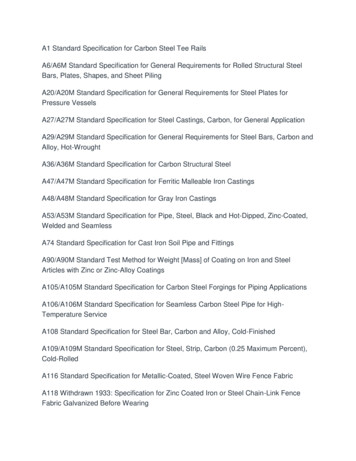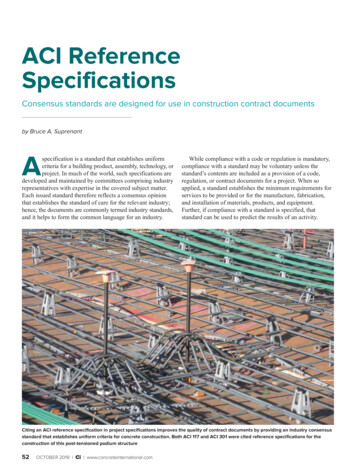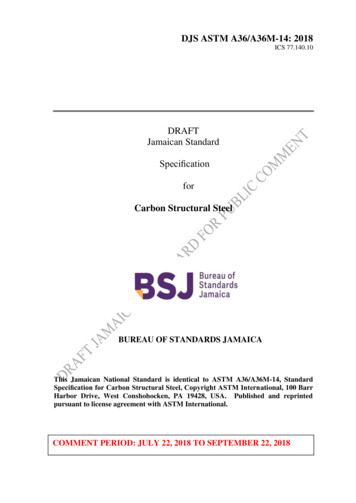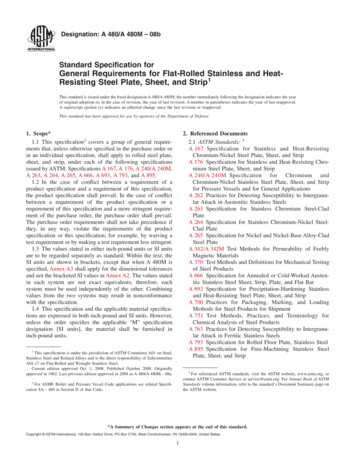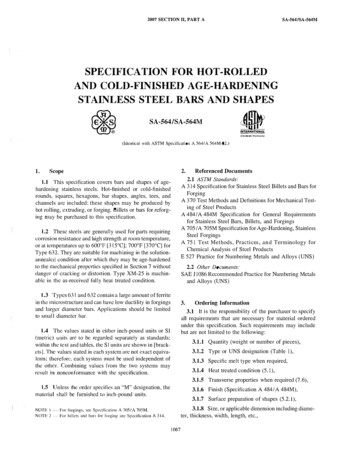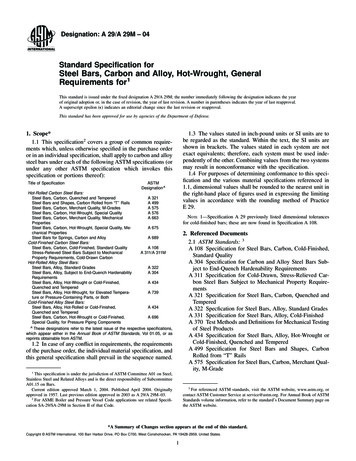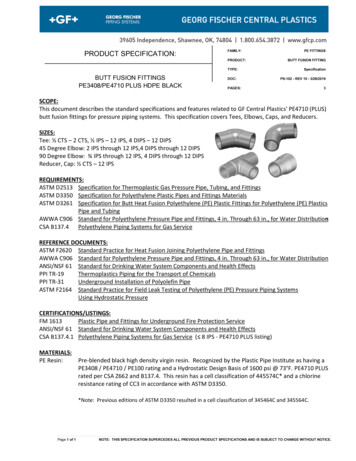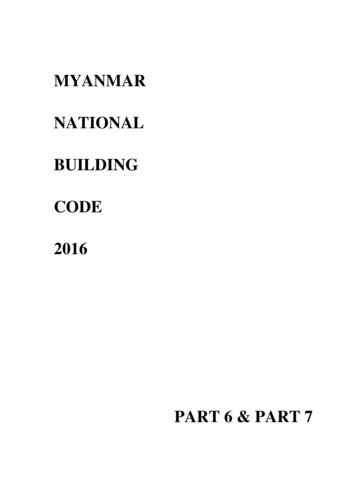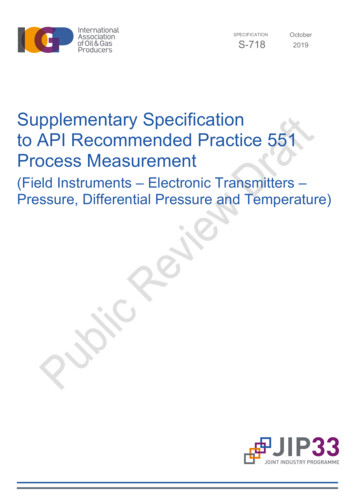
Transcription
SPECIFICATION SPN220/3Investigation and Clinical Management of Patients with a positive DAT with andwithout HaemolysisThis Specification replacesSPN220/2.1Copy NumberEffective13/04/17Summary of Significant ChangesHyperhaemolysis section removed, as this is now covered in SOP4743.Paragraph on Paroxysmal nocturnal haemoglobinuria deleted.Subtitle (page 5) changed to: “haemolytic anaemia with cold-reacting antibodies”.Significant modifications to the section on CHAD have been made.Updated references added.One-stage DLT deleted, covered in SOP1150.Author name changed.PurposeTo ensure that a uniform RCI Clinical Policy for the investigation and clinical management ofpatients with a positive DAT with and without haemolysis is implemented throughout the NHSBT.DefinitionsApplicable DocumentsSOP4742 – Investigating samples with apositive DATSOP1149 – Direct antiglobulin testMPD1071 – Processing samples in RCIESD121 – BCSH Guidelines for pretransfusion compatibility procedures inblood transfusion laboratories 2012SOP1150 – Donath Landsteiner TestSOP1151 – Drug induced haemolyticanaemia techniquesSOP4728 – ABO and D grouping in RCIMPD1057 – RBC genotyping of samples byfluogene in RCIThis copy is uncontrolled unless printed on ‘Controlled’ paperAuthor(s): Dr Aleksandar Mijovic(Template Version 01/04)Page 1 of 13
SPECIFICATION SPN220/3Investigation and Clinical Management of Patients with a positive DAT with andwithout HaemolysisSignificance of a Positive DATThe direct antiglobulin test (DAT) is generally used to determine whether red cells have beencoated, in vivo, with immunoglobulin, complement, or both. A positive DAT, with or withoutshortened red cell survival, may result from:1.Autoantibodies to intrinsic red cell antigens, e.g. Autoimmune Haemolytic Anaemia2.Alloantibodies in a recipient’s circulation, reacting with antigens on recently transfused donorred cells which may or may not be associated with symptoms, signs and biochemical changesof an acute or delayed haemolytic transfusion reaction (AHTR or DHTR).3.Alloantibodies in donor plasma / derivatives that react with recipients’ red cells for example:a) Transfusion of Group O platelets with high titre anti- A,B to Group A/B recipientb) Intravenous Immunoglobulin (IVIg) may contain ABO antibodies / anti-D1.4.Alloantibodies in maternal circulation that cross the placenta and coat fetal red cells which mayor may not be associated with symptoms, signs and biochemical changes of haemolyticdisease of the fetus and newborn (HDFN).5Antibodies produced by passenger lymphocytes in transplanted organs.2Passenger lymphocytes of donor origin produce antibodies directed against ABO or otherantigens on the recipient’s cells, causing a positive DAT.6.Drug-induced haemolytic anaemia (e.g. Methyldopa-type, Penicillin type), usually IgG /-C3d.7.DAT positive with complement components onlya) About 10% of patients with warm AIHA have red cells with a positive DAT due to C3coating alone.3 These AIHAs can be caused by warm-reacting IgM antibodies, or IgM IgGantibodies.4b) Cold haemagglutinin disease / Paroxysmal Cold Haemoglobinuria.c) Drug Induced (Drug-dependent-Immune complex type).8.Non-antibody immunoglobulins associated with red cells in patients withHypergammaglobulinemia.5 Multiple Myeloma or recipients of antilymphocyte globulin (ALG) orantithymocyte globulin (ATG). 69.Elevated levels of IgG or complement have been noted on the red cells of patients with sicklecell disease, -thalassemia, renal disease, autoimmune disorders (including systemic lupuserythematosus), AIDS, and other diseases with elevated serum globulin or blood urea nitrogen(BUN) levels.1-710. A positive DAT, without clinical manifestation of immune mediated red cell destruction, hasbeen reported in 1:7000 healthy blood donors.8Interpretation of positive DATs must include the patient’s history, clinical data, and the resultsof other laboratory tests.This copy is uncontrolled unless printed on ‘Controlled’ paperAuthor(s): Dr Aleksandar Mijovic(Template Version 01/04)Page 2 of 13
SPECIFICATION SPN220/3Investigation and Clinical Management of Patients with a positive DAT with andwithout HaemolysisLaboratory investigations of Patients with Positive DAT in warm antibody inducedAutoimmune Haemolytic Anaemia (WAIHA).WAIHA may occur as idiopathic or secondary to other diseases (chronic lymphocytic leukaemia,lymphoma, systemic lupus erythematosus, ulcerative colitis, myelodysplastic syndromes).MPD1071 describes how samples are processed in RCI.1.Determine ABO, Rh and Kell phenotype. if the patient’s RBC are heavily coated withantibodies (strong positive DAT): warm saline wash or chloroquine diphospate treatmentcan be used (SOP4728). Alternatively, Rh DCcEe, M N S s, K, k, Fya, Fyb, Jka, Jkb can bepredicted with a high level of accuracy by molecular testing (MPD1057).2.Direct antiglobulin test: BioRad cards are used on all investigations. This might detectIgA only AIHA, if using polyspecific anti-human globulin (AHG) or AIHA due to low affinityautoantibodies (SOP1149).3.Antibody identification: by standard methods (indirect antiglobulin test) auto control.Variation in strength of reactions may indicate the presence of both allo and autoantibodies.If DAT positive, there is no history of transfusion during the previous 3 months, no evidenceof AIHA and no free antibody is present, no other tests are required.4.Autoadsorption technique: if reactions obtained by IAT are uniformly weak with all panelcells it is unlikely that there is a significant underlying alloantibody and adsorptions areunnecessary. Autoadsorptions are performed using the patient’s red cells treated with areagent called ZZAP which contains dithiothreitol and cysteine-activated papain.Autoabsorption should not be performed if the patient has been transfused within the past 3months to ensure allogeneic red cells are not present. Extended blood group serological ormolecular typing will assist in the identification of alloantibodies.5.Differential adsorption technique: the red cells employed in the differential adsorptiontechnique must be carefully selected to include all clinically significant blood groups andgenerally performed only in the following circumstances: pan-reacting antibodies are detected and the patient has been transfused within the lastthree monthsor if there are insufficient red cells (due to a low hct and urgent transfusion requirement) toperform auto-adsorptionor if auto-adsorption fails to remove (or weaken significantly) pan-reactive antibodies.6.Red cell eluate study to be undertaken:a)If there is history of transfusion within 1 month with an increase in the transfusionrequirement and/or a change in the serology (SOP4742).b)Evidence of haemolysis with no demonstrable allo or autoantibody in the serum.Eluate should be tested, even if DAT negative, if immune haemolysis is stronglysuspected 9 (discuss with laboratory).This copy is uncontrolled unless printed on ‘Controlled’ paperAuthor(s): Dr Aleksandar Mijovic(Template Version 01/04)Page 3 of 13
SPECIFICATION SPN220/3Investigation and Clinical Management of Patients with a positive DAT with andwithout Haemolysisc)When adsorption studies are inconclusive, especially in patient transfused within thepast 3 months.d)Post ABO mismatched haemopoietic cell transplantation.Examples of positive DAT and no elutable antibody are seen in cases with:1)penicillin type induced haemolysis2)patients with circulating immune complexes3)patients with high paraprotein / gammaglobulinsIf a specific antibody is eluted, the patient’s red cells should be checked if possible for theantigens concerned. The presence of alloantibodies in an eluate suggests:1)delayed transfusion reaction2)haemolytic disease of the newborn3)“mimicking” autoantibodies 10,11Policy for selection/provision of Cross-Matched Blood in WAIHA casesThe chief value of transfusion is to gain time for other therapies (e.g. Corticosteroids) to work.Blood must be transfused cautiously and for appropriate indications. Rapid haemolysis e.g. Hb 5g/dL or life threatening symptomatic anaemia (angina, respiratory distress, cerebral ischaemia,progressive cardiac decompensation associated with reticulocytopenia constitutes a medicalemergency).1.Blood selected for patients with clinically significant allo-antibodies must lack thecorresponding antigens.2.Select K negative blood of the same ABO group and of Rh type compatible with that of thepatient eg:11Patient Rh phenotyperrR1rR1R1R1R2R2rR2R2SelectrrE Neg (R1R1 rr or R1r)R1R1Any Rh phenotypeC Neg (R2R2 rr or R2r)R2R2This will avoid stimulating the production of Rh/K alloantibodies and will prevent transfusionreactions from such antibodies already present but masked by the autoantibodies.This copy is uncontrolled unless printed on ‘Controlled’ paperAuthor(s): Dr Aleksandar Mijovic(Template Version 01/04)Page 4 of 13
SPECIFICATION SPN220/3Investigation and Clinical Management of Patients with a positive DAT with andwithout HaemolysisIt is preferable to select blood using this principle even if the patient’s autoantibody showsspecificity within the Rh system.12,13 The only exception would be if there was activeongoing haemolysis with clear-cut single Rh specificity (e.g. anti-e), in which case it mightbe considered that the advantage of possible increased red cell survival would outweigh thepotential for stimulating alloantibody production.143.Crossmatched units that are serologically incompatible but considered appropriate for thepatient should be issued as “SUITABLE FOR”.4.If transfusion of ABO Rh, K compatible red cells does not result in expected rise in Hb,extend the phenotype (or predicted phenotype if molecular methods are being employed) toinclude Ss, Kidd and Duffy and contact the NHSBT consultant to consider/discuss withhospital clinician the option of further transfusion, with IVIg / steroid cover.155.In the situation where the need for blood is urgent and there is insufficient time to performautoadsorption/differential adsorption test, select ABO, Rh phenotype compatible, Knegative blood. These are the most common specificities of alloantibodies found in AIHA.16In extreme circumstances, transfusion under IVIg / steroid cover should be considered.15The decision to transfuse these units in life threatening emergency requires adequateconsultation between hospital clinician and NHSBT consultant.Comment. No critically ill patient with autoimmune haemolytic anaemia should die throughlack of blood.6.Once alloantibodies are excluded after adsorption studies at a reference laboratory, thehospital may select the same ABO, Rh and K phenotype units and use an immediate spincross match technique for compatibility testing prior to issue of blood.16 The laboratoryresults and the advice provided to the hospital by the reference laboratory should be welldocumented.A sample obtained within 72 hours of the previous transfusion is acceptable for serologicalinvestigation for AIHA to exclude additional alloantibodies and to select suitable units.17,18DAT negative AIHADAT-negative AIHA has been reported in about 6% of all warm AIHA. There are several possiblemechanisms: a) low affinity IgG antibodies which may dissociate from the red cells during washingfor DAT, b) low number of IgG molecules on the red cells, undetectable by standard DAT butdemonstrable by more sensitive techniques such as solid phase enzyme-linked anti-globulin test,flow-cytometry, c) AIHA caused by non-IgG (e.g. IgA) antibodies.19 Sachs et al reported that 4.6%DAT-negative patients suspected to have immune haemolysis had red cell auto- or allo-antibodiesdetectable by elution.9Haemolytic anaemias due to cold-reacting autoantibodiesCold agglutinin diseaseThe acute transient form of CAD is usually associated with mycoplasma pneumoniae infection orinfectious mononucleosis, a chronic form usually seen in the elderly, can be idiopathic orThis copy is uncontrolled unless printed on ‘Controlled’ paperAuthor(s): Dr Aleksandar Mijovic(Template Version 01/04)Page 5 of 13
SPECIFICATION SPN220/3Investigation and Clinical Management of Patients with a positive DAT with andwithout Haemolysisassociated with lymphoma, Waldenstrom’s macroglobulinaemia and chornic lymphocyticleukaemia.20DAT is typically positive for C3d, and negative (or, occasionally, weakly positive) for IgG. 20Cold autoantibody is usually IgM, but examples of cold reacting IgA autoantibodies (e.g. anti-Pr)have also been reported. 21 IgM Antibodies usually have anti-I specificity (anti-i in the postinfectious form of CHAD), but autoantibody specificity is not diagnostic of the underlying conditionof CHAD and clinical relevance depends on the thermal range of the antibody.Testing for clinically significant cold agglutininsA practical screening procedure is to incubate the patient’s serum with normal red cells suspendedin saline, at room temperature for 30-60 minutes. Negative test practically rules out clinicallysignificant antibody. If the screening test is positive, further tests are necessary. To distinguishbetween clinically significant cold agglutinins, and those that are not antibody titration and/or itsthermal amplitude (highest temperature at which the antibody binds to red cell) can be tested.Clinically significant cold agglutinins usually have a 1:500 – 1:1000 titre at 4oC. ColdHaemagglutinins of thermal amplitude 30oC (detected by tube NISS direct agglutination technique)are considered to be a reasonable indicator of clinical significance. 22Laboratory testing problems that cold agglutinins may causeSamples for cold agglutinin titre/thermal amplitude should be transported to laboratory at 37oC. Asthis is often not practical, EDTA-anticoagulated samples should be re-warmed at 37oC for 1 hourbefore testing. 22The thermal range of the antibody is more important than the agglutination titre for clinicalpurposes. (ref a and b).Cold autoantibody may agglutinate all cells within the reverse ABO group leading to discrepantABO typing. If these findings are correctly interpreted as a non-specific cold reaction and the testsare repeated at 37oC the reactions will disappear.Potent cold reactive autoantibodies reacting by IAT at 37oC may mask the underlying alloantibodiesactive at 37oC. The patient’s plasma can be treated with DTT (DTT is used to treat serum toprevent IgM antibodies acting as agglutinins, by disruption of J chains) and post DTT treatedsample should be tested at 37oC by IAT technique using monospecific anti IgG reagent.Alternatively, alloadsorptions at 4oC may be performed. Donor red cells should be transfusedthrough a blood warmer. 24 Acute forms of CHAD with infections often have abrupt but shortclinical course. The chronic form may require therapy. Corticosteroids, IVIg and splenectomy areoften, but not always, ineffective in CHAD. Rituximab has been tried as 1st line and Fludarabine /Rituximab as 2nd line. 25Positive DAT by complement/IgG and IgM (mixed-type AIHA)In approximately 7% of cases with AIHA, both warm IgG autoantibody and cold IgM autoantibodyare simultaneously detected in the patient’s serum. These cases are referred to as mixed-typeAIHA. The diagnosis of mixed-type AIHA requires thorough serologic studies. DAT is positiveThis copy is uncontrolled unless printed on ‘Controlled’ paperAuthor(s): Dr Aleksandar Mijovic(Template Version 01/04)Page 6 of 13
SPECIFICATION SPN220/3Investigation and Clinical Management of Patients with a positive DAT with andwithout Haemolysiswith both IgG and C3d. Demonstration of both warm IgG autoantibody and cold IgM autoantibodyreacting at high thermal amplitude ( 30C) is essential for diagnosis.23Mixed-type AIHA can be further classified into idiopathic or secondary, the latter often beingassociated with systemic lupus erythematosus or lymphoma, or occurring after haemopoietic celltransplantation.PAROXYSMAL COLD HAEMOGLOBINURIA (PCH)PathophysiologyPCH is caused by an IgG biphasic autoantibody, usually with anti-P specificity and commonly seenas acute condition in children. This antibody binds to the RBC in the cold, but activates complementand causes haemolysis at 37ºC. Cases may be idiopathic or can be secondary to acute viralinfection in children. Chronic PCH is a very rare condition affecting adults and may be associatedwith congenital or tertiary syphilis or lymphoma.Clinical featuresThe most common clinical features include haemoglobinuria, jaundice and pallor preceded by viralinfection.26 Acute, transient PCH is characterised by a sudden onset of acute intravascularhaemolysis, most frequently seen in young children, following a viral illness. It has been reportedfollowing measles, mumps and chicken pox, but in many cases, no specific viral infection can beidentified.27,28 Relative reticulocytopenia has been noted in some patients with PCH at the time ofpresentation.27 Parvovirus induced PCH has been reported in association with reticulocytopenia.29Erythrocyte P antigen is a viral receptor for Parvovirus infection of red cell precursors. Awarenessand correct diagnosis of PCH is important, as haemolysis is transient in nature and can be haltedby keeping the patient warm.Serological investigation and pretransfusion testingPCH is caused by an IgG autoantibody, and the biphasic nature of the antibody has beendemonstrated by either the Direct or Indirect Donath-Landsteiner Test (DLT).Direct Antiglobulin TestThe DAT is positive for complement only. The biphasic IgG molecules will already have dissociatedin vivo.Antibody ScreeningBCSH guidelines (ESD121) recommend the use of IAT only at 37oC for pre-transfusion antibodyscreening, without an additional screening technique, since IAT 37oC methods used alone candetect the majority of clinically significant alloantibodies.This copy is uncontrolled unless printed on ‘Controlled’ paperAuthor(s): Dr Aleksandar Mijovic(Template Version 01/04)Page 7 of 13
SPECIFICATION SPN220/3Investigation and Clinical Management of Patients with a positive DAT with andwithout HaemolysisNegative antibody screen by the standard IAT at 37oC is a common finding in a suspected case ofPCH because of the low thermal amplitude nature of the autoantibody. If the antibody investigationis carried out at a lower temperature (15ºC), in suspected PCH cases, either with enzymes ortreated red cells in a direct agglutination technique or by IAT, in suspected PCH cases, pan reactivecold antibodies may be detected as the majority of autoantibodies show anti-P specificity withthermal amplitude range up to 15-24oC. Usually the antibody titre is low (less than 64) even wheninvestigated at 4oC.30 Anti-P specificity can be confirmed at the reference laboratory.Note: A low serum complement level and/or a low antibody level can result in a negative outcometo the tests. Negative results, therefore, do not rule out PCH. Donath-Landsteiner Test (DLT) is theconfirmatory test for PCH.Donath-Landsteiner Test (DLT)The nature of the biphasic antibody can be demonstrated by DLT. The DLT can be performed aseither a Direct or Indirect procedure. False results are not uncommon in the Direct DLT for one ormore reasons stated below:311) Low antibody level2) Low complement level (complement is consumed during the haemolytic process)3) Due to the presence of C3dg on the patient’s red cells (resistant to complement-mediatedhaemolysis).Two-stage indirect DLT (see SOP1150)Globoside is the most abundant red cell membrane glycolipid, and is present in the serum of all P individuals to variable amounts. Addition of ABO compatible fresh serum therefore, as a source ofcomplement, could result in cross-reaction with anti-P and can lead to a false negative indirectDLT.32 This can be overcome by the two-stage indirect DLT.In the two-stage indirect DLT, ABO compatible, fresh serum is only added to the red cell-serumsuspension following the initial 1 hour incubation at 0oC. This prevents antibody inhibition during thecold phase, and allows maximum sensitisation of the red cells.32Note: Indirect DLT sample handling (collection and separation of serum from whole blood) shouldbe strictly at 37oC to prevent autoadsorption which may cause false negative result. False negativeis common with one-stage indirect DLT and should proceed to two-stage indirect DLT if indicated.In some cases the Donath-Landsteiner antibody is only detectable using enzyme (papain) treatedcells in the two-stage indirect Donath-Landsteiner test.Transfusion SupportAwareness, a high index of suspicion of PCH and a correct diagnosis are important, as keeping thepatient warm at an ambient temperature of 30oC will assist recovery. In rare severe cases,however, when blood transfusion may be required, ABO, Rh and K compatible units should beselected for the crossmatch, and the use of blood warmers may provide some protection against aThis copy is uncontrolled unless printed on ‘Controlled’ paperAuthor(s): Dr Aleksandar Mijovic(Template Version 01/04)Page 8 of 13
SPECIFICATION SPN220/3Investigation and Clinical Management of Patients with a positive DAT with andwithout Haemolysishaemolytic reaction.24 P- (pp or Pk) blood is not readily available, but should be considered if thereis no response to transfusion of P cross-match compatible blood. In such a case, the referencecentre should be contacted to explore the availability of P- units at the National Frozen Blood Bank.Steroids may be helpful.Drug induced Immune Haemolytic AnaemiaIt may be evident from the medical history and serological investigation that drug-induced immunehaemolytic anaemia should be considered. In cases where drug-induced immune haemolysis issuspected, please refer the case to Sheffield RCI laboratory (see list of drugs implicated in immunehaemolytic anaemia).NB: The presence of free autoantibodies in the serum may interfere with investigations for druginduced haemolysis. Please check with the Sheffield Blood Centre before agreeing to theseinvestigations being undertaken.Mechanisms of drug-induced immune haemolytic anaemia33-361.Drug Adsorption: Antibodies directed against certain drugs that bind to red cell membranes,(e.g. high dose IV penicillin/some cephalosporins): Positive DAT due to IgG coating. Antibodyeluted from the red cells reacts with penicillin-coated red cells but not with uncoated red cells.2.Non-specific adsorption: First generation cephalosporins alter the red cell membrane, whichinduces non-specific adsorption of proteins / immunoglobulins. Only positive DAT with nohaemolysis.3.Drug-dependent Immune-Complex Mechanism: Complement components due to formation ofdrug/anti-drug immune complexes (e.g. Quinidine / Phenacetin).4.Drug-Independent Autoantibody Production: Serologically indistinguishable from idiopathicWAIHA. Red cells are coated with IgG, eluate/serum reacts with all cells tested.(e.g. L dopa, Procainamide, Mefenamic Acid, Fludarabine).Second and third generation cephalosporins are increasingly associated with severe AIHA.Some of these drugs may induce drug independent autoantibodies and others may also inducedrug dependant antibodies through drug adsorption mechanism.This copy is uncontrolled unless printed on ‘Controlled’ paperAuthor(s): Dr Aleksandar Mijovic(Template Version 01/04)Page 9 of 13
SPECIFICATION SPN220/3Investigation and Clinical Management of Patients with a positive DAT with andwithout HaemolysisDrugs Implicated in Immune Haemolytic AnaemiaAcetaminophene2Acetylsalicylic sis,tetanus) 3Triple amic acid3Mephalan2Methadone*2Methysergide2,3Nalidixic OxacillinTicarcillinUnasyn (ampicillin ticarcillin d or possible drug adsorption mechanismDocumented or possible immune-complex mechanismDocumented or possible autoimmune mechanism.Reported to cause a positive DAT without overt haemolysisRef: Clinical Practice of Transfusion Medicine, 3rd Ed., Churchill LivingstoneL.D.Petz, Drug Induced Immune Haemolytic Anaemia (Pg 494-496)This copy is uncontrolled unless printed on ‘Controlled’ paperAuthor(s): Dr Aleksandar Mijovic(Template Version 01/04)Page 10 of 13
SPECIFICATION SPN220/3Investigation and Clinical Management of Patients with a positive DAT with andwithout HaemolysisREFERENCES1.Toy PT, Chin CA, Reid ME, Burns MA. Factors associated with positive direct antiglobulintests in pretransfusion patients: A case control study. Vox Sang 1985;49:215-220.2.Ramsey G.Red cell antibodies arising from solid organ transplants. Transfusion1991;31:76-86.3.Sokol RJ, Hewitt S, Stamps BK. Autoimmune haemolysis: An 18-year study of 865 casesreferred to a regional transfusion centre. Br.Med J 1981;282:2023-7.4.Amdt PA, Leger RM, Garratty G. Serological findings in autoimmune haemolytic anemiaassociated with immunoglobulin M warm antibodies. Transfusion 2009; 49: 235-242.5.Heddle N, Kelton JG, Turchyn KL, Ali MAM. Hypergammaglobulinemia can be associatedwith a positive direct antiglobulin test, a non-reactive eluate, and no evidence of haemolysisTransfusion 1988; 28:29-33.6.Shelman IA, Petz LD. Red cell compatibility testing: Clinical significance and laboratorymethods. In: Petz LD, Swixher SN, Kleinman S, et al, eds. Clinical practice of transfusionmedicine, 3rd ed. New York: Churchill Livingstone, 1996:199-244.7.Clark JA, Tanley PC, Wallas CH. Evaluation of patients with positive direct antiglobulin testsand non-reactive eluates discovered during pretransfusion testing. Immunohaematology1992; 8:9-12.8.Win N, Islam SIAM, Peterkin MA, Walker ID. Positive Direct Antiglobulin Test due toAntiphospholipid antibodies in normal healthy Blood Donors. Vox Sanguinis1997;Vol.72,No.3:182-184.9.Sachs U, Roder L, Santoso S, Bein G. Does a negative direct antiglobulin test excludewarm autoimmune haemolytic anaemia? A prospective study of 504 cases. British Journalof Haematology 2006; 132: 655-656.10.Domen RE, Clarke A. Case reports: red blood cell autoantibodies mimicking alloantibodiesImmunohaematology 1991;7:98-101.11.Engelfriet CP, Overbeeke MAM, vondem Bourne AEGKr. Autoimmune hemolytic anemiaSemin Hematol 1992; 29:3-12.12.Sokol RJ. Patients with red cell autoantibodies; selection of blood for transfusion. Clin LabHaemat 1988;10:157-164.13.Sokol RJ, Booker DJ, Stamps R. Investigation of patients with autoimmune haemolyticanaemia and provision of blood for transfusion. ACP Broadsheet No. 145. J Clin Pathol1995;48:602-610,This copy is uncontrolled unless printed on ‘Controlled’ paperAuthor(s): Dr Aleksandar Mijovic(Template Version 01/04)Page 11 of 13
SPECIFICATION SPN220/3Investigation and Clinical Management of Patients with a positive DAT with andwithout Haemolysis14.Sigmund KE. Direct antiglobulin testing. In: Pierce SR, Wilson JK eds. Approaches toserological problems in the hospital transfusion service. Arlington VA. AmericanAssociation of Blood Banks 1985:101-3315.Kohan AL. High-dose intravenous immunoglobulin in no -ABO transfusion incompatibility.Vox Sang 1994;67:195-19816.James P, Rowe GP, Tozzo GG. Elucidation of alloantibodies in autoimmune haemolyticanaemia. Vox Sang 1988; 54:167-171.17.Lee E, Redman M, Burgess G, and Win N: Do patients with autoantibodies or clinicallyinsignificant alloantibodies require an indirect antiglobulin test crossmatch? Transfusion2007; Jul; 47(7): 1290-5.18.Shulman IA, Nelson JM, Nakayama R: When should antibody screening tests be done forrecently transfused patients? Transfusion 1990;30:39-41.19.British Committee for Standards in Haematology, Milkins C, Berryman J, Cantwell C, ElliottC, Haggas R, Jones J, Rowley M, Williams M and Win N. Guidelines for pre-transfusioncompatibility procedures in blood transfusion laboratories. Transfusion Medicine 2013; 23:3-35.20.Berentsen S. How to manage cold agglutinin disease. Br J Haematology 2011; 153:309-317.21.Roelcke D, Haik H, Kreft H, Macdonald B, Pereira A, Habibi B. IgA cold agglutininsrecognise Pr and Sa antigens expressed on glycophorins.Transfusion 1993;33:472-475.22.Petz L. Cold antibody AIHA. Blood Review 2008; 22:1-15.23.BSCH Guidelines: The diagnosis and management of primary autoimmune haemolyticanaemia. August 2016.24.Duffy TP. Autoimmune haemolytis anaemia and paroxysmal nocturnal haemoglobulinuriain Rossi’s principles of transfusion medicine: 4th edition. Wiley-Blackwell. pp 321-343.25.Berentsen S, Randen U, Vagan A M, Hjorth-Hansen H, Anders V, et al. High response rateand durable remissions following fludarabine and rituximab combination therapy for chroniccold aggulutinin disease. Blood 2010; 116(17):3180-3184.26.Win N, Tiwari D, Keevil V, Needs M and Lakhani A. Mixed-type autoimmune haemolyticanaemia: Unusual cases and a case associated with splenic T cell angioimmunoblastic nonHodgkins lymphoma. Hematology 2007; 12(2):159-162.27.N M Heddle. Acute Paroxysmal Cold Hemoglobinuria. Transfusion Medicine Reviews.Vol. III, No. 3 (July);1989:219-229.28.Vogel JM, Hellman M, Moloshok RE: Paroxysmal cold hemoglobinuria ofNonsyphilitic etiology in two children. J. Pediatr 1972;81:974-977.This copy is uncontrolled unless printed on ‘Controlled’ paperAuthor(s): Dr Aleksandar Mijovic(Template Version 01/04)Page 12 of 13
SPECIFICATION SPN220/3Investigation and Clinica
b) Cold haemagglutinin disease / Paroxysmal Cold Haemoglobinuria. c) Drug Induced (Drug-dependent-Immune complex type). 8. Non-antibody immunoglobulins associated with red cells in patients with Hypergammaglobulinemia.5 Multiple Myeloma or recipients of antilympho

